Japan’s public transportation system is praised for its reliability, speed and convenience. Having a prepaid transportation IC card in Japan makes for seamless travel and it can even be used as a payment method for shopping. Discover the benefits of using a Japan IC card and the different types of cards there are.
First Published: 2024-01-28
Updated: 2024-05-31
Table of Contents
- Japan IC Cards for Getting Around Easily
- Benefits of Japan IC Card, Reasons to Get One
- 10 Nationwide Interoperable Japan IC Cards
Japan IC Cards for Getting Around Easily

Japan’s public transportation system consists of subways, trains, taxis, buses, and more. For everyday work or school commute, people generally use the subway, train or bus. As such, IC cards in Japan are indispensable tools for locals and tourists alike for getting around easily and efficiently.
With an IC card, there is no hassle of buying a ticket every time you need to use the train, and no digging through your wallet for cash every time, just “tap and go”. It saves time and keeps you from having to carry spare change everywhere you go.
What are IC Cards?

IC Cards are “integrated circuit” cards, also known as “smart cards”. Credit cards, debits, SIM cards, etc. cards with IC chips are considered IC cards. In Japan, the term ICカード (IC ka-do), aka “IC Card”, generally refers to transportation IC cards, called 交通系ICカード (Koutsuukei IC ka-do). IC cards are generally physical cards, though Suica, PASMO and ICOCA have become Android and ApplePay compatible.
Examples of Japan Transportation IC Cards are Suica, PASMO, and ICOCA.
What is Denshi Money (電子マネー)?
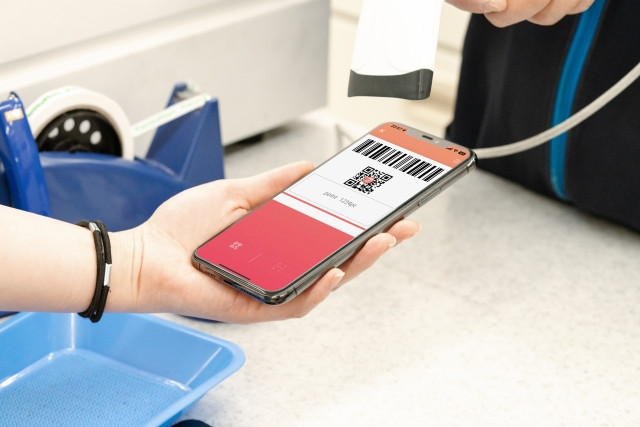
電子マネー (Denshi Mane-) refers to “eMoney”; 電子 (Denshi) meaning “electronic”, and マネー (Mane-) the Katakana for “money”. A smartphone or physical card is required to use Denshi Money. Nowadays, most people use smartphones.
Examples of Japan eMoney are QUICPay, iD, PayPay, RakutenPay, LINE Pay and WAON.
The biggest difference between IC Cards and Denshi Money is their purpose. IC Card is mainly used for transportation purposes, while Denshi Money is for making purchases. However, nowadays as prepaid IC cards have evolved to become payment methods for shopping, the lines have become blurred.
Writer's Pick
Benefits of Japan IC Card, Reasons to Get One
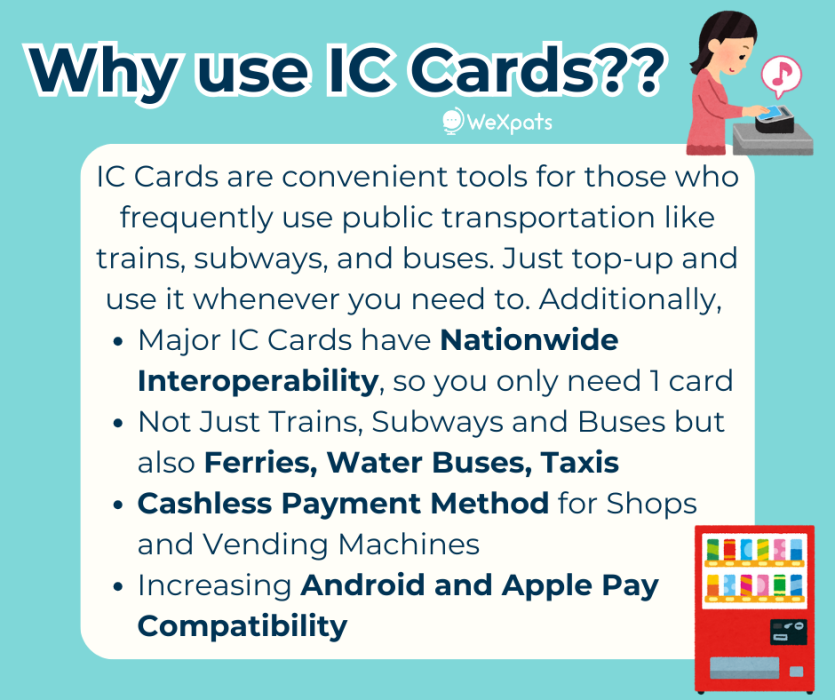
Apart from the obvious benefit (convenient use of public transportation) of having an IC card, there are many other benefits as well.
Major IC Cards Nationwide Interoperability System
IC cards that are part of the nationwide interoperability system can be used across different regions and transportation systems, allowing for easy travel between cities and parts of Japan without the need for multiple cards. Note that there are some exceptions, for example local buses in some areas.
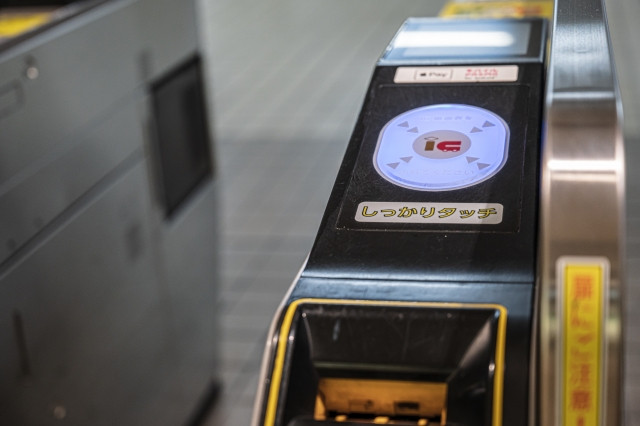
How do I know if my IC card can be used?
If the IC nationwide interoperability symbol mark is displayed (like in the image above), it is highly likely that any major IC card can be used. For confirmation, check your IC card’s operating company website for usable area information.
Not Just Trains, Subways and Buses
IC Cards can be used on other modes of transportation as well. It really depends on the service’s operating company. There are ferries, water buses and taxis around Japan that accept IC card payments. As the usage of IC cards as a payment method increases, more and more services and establishments will come to accept them.
Cheaper Subway and Train Fares in Some Areas
In Tokyo, subway and train fares for IC cards are usually cheaper by a few yen compared to ticket fares. This is because IC cards can be charged in 1 Yen increments but paper tickets will be rounded up, or in some cases rounded down. The price difference is not much but for frequent travellers and commuters, the difference will gradually add up.
There are other places outside of Tokyo that also do this but generally most places charge the same fares for paper tickets and IC cards.
Payment for Shopping, Vending Machines, and Select Shops
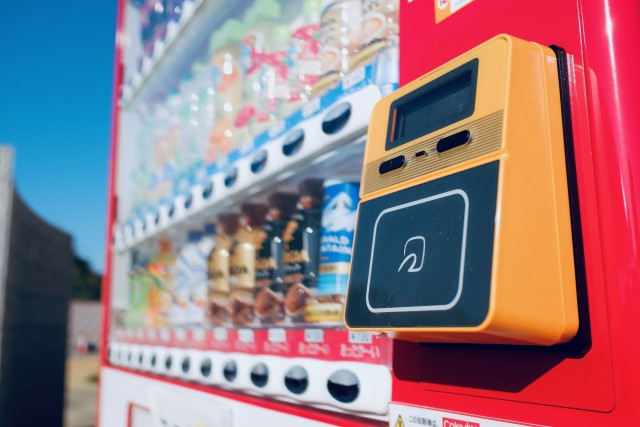
IC cards have been steadily growing as a popular form of payment method, mostly vending machines but also convenience stores, supermarkets, and select shops. Shops and facilities at train stations are more likely to accept IC cards. Even so, eMoney (Denshi Money) is still the more popular option.
Android and ApplePay Compatible IC Cards Increasing
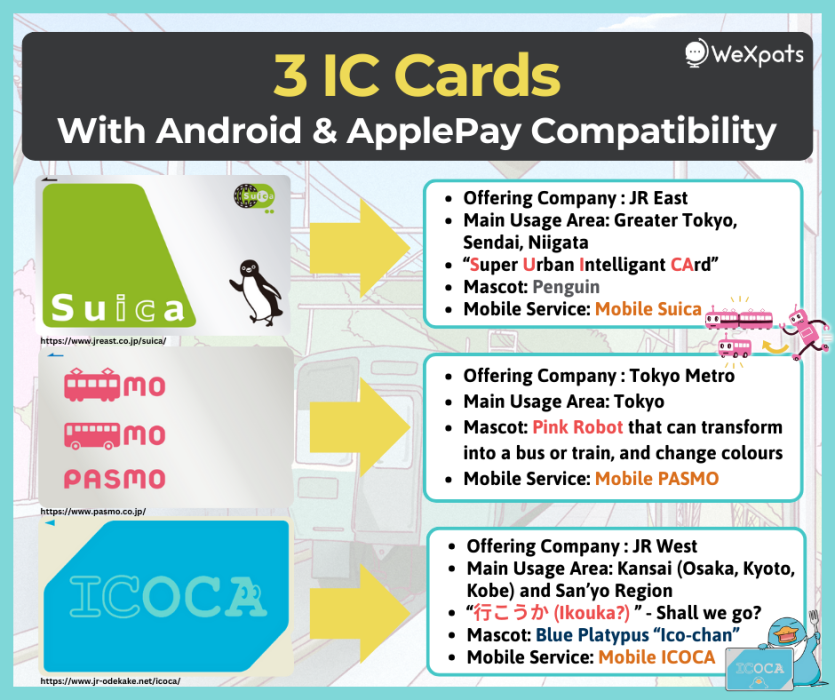
Phone compatible transportation IC cards first became available in Japan in 2006, in the form of Mobile Suica for Osaifu-Keitai mobile phones.
What is Osaifu-Keitai (おサイフケータイ)?
Osaifu-Keitai literally translates to “Wallet Mobile” - おサイフ = お財布 (Osaifu) meaning “wallet”, ケータイ = 携帯 (Keitai) meaning “cell phone” or “mobile phone”. Osaifu-Keitai are mobile phones with RFID smart card systems built into them, allowing for contactless payment, personal identification, and etc. Only Osaifu-Keitai smartphones can be used for mobile IC cards.
Mobile Suica (モバイルSuica)
▶iPhoneでの「エクスプレスカード設定」方法がより簡単に◀
— モバイルSuicaサポート【JR東日本公式】 (@JR_Mobile_Suica) May 16, 2019
Suicaの「エクスプレスカード設定」方法が変わりました。再設定や機種変更を行った際は、都度設定をご確認ください。また、定期券をご利用の場合、当該Suicaを必ずエクスプレスカードに設定してください。
https://t.co/ZU3st8hCA4 pic.twitter.com/dKAkGdR6qV
In 2016, Mobile Suica became compatible with ApplePay, but only for iPhone 7 models released in Japan that included the Osaifu-Keitai function. With the release of later iPhone models that included RFID smart card systems, any iPhone 8 and later models purchased anywhere in the world could be used for mobile IC cards.
In 2018, Mobile Suica became GooglePay compatible. Only Android phones that support Osaifu-Keitai function (aka bought in Japan) and had their Google Account region set to Japan could use Mobile Suica.
Mobile PASMO (モバイル PASMO)
PASMOが Google Pay に対応しました!Android 端末でのご利用が、さらに簡単・スピーディーになります。はじめ方はこちら。https://t.co/P8YERFYvB6#PASMO #Google #Android #モバイルPASMO pic.twitter.com/TVx3JJXqZs
— PASMO 【公式】 (@pasmonorobot) September 28, 2022
Tokyo Metro’s Mobile PASMO became the second mobile IC card service in Japan after JR’s Mobile Suica in 2020. In March 2020, Android compatible Mobile PASMO was launched, followed by ApplePay compatible service in October of the same year. The usage conditions were the same as for Mobile Suica phones - iPhone 7 (Japan release), iPhone 8 and later models, and Android phones with Osaifu-Keitai function.
Mobile ICOCA (モバイル ICOCA)
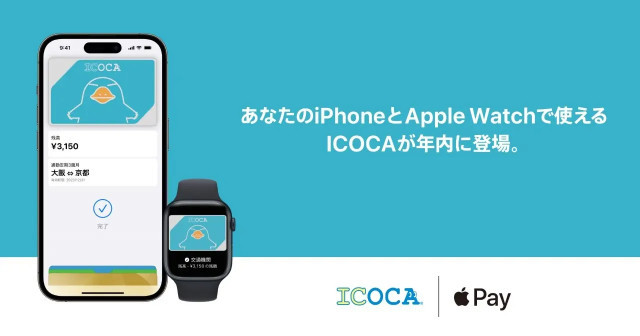
Image from PR Times.
In 2023, Mobile ICOCA became the third and latest available Japan mobile IC card service. Offered by JR West, ICOCA is Osaka’s most popular choice of IC card, so it was only a matter of time until a mobile compatible version would become available.
Read more about Osaka IC Cards - PiTaPa and ICOCA here, and check out discount travel passes for the Osaka and Kansai area.
At present, there are only 3 available mobile IC cards in Japan, but more may come in time.
10 Nationwide Interoperable Japan IC Cards
Image from Twitter.
There are over 30 types of transportation IC cards in Japan including region-specific, city-specific, and public transportation type (bus / subway / train) specific cards. However, you need only concern yourself with the 10 major ones that have nationwide interoperability.
The Nationwide Interoperable Service (全国相互利用サービス) was launched in March 23, 2023. It celebrated its 10th Anniversary in 2023 with IC card companies celebrating by offering limited edition design IC cards, and etc. There are 10 Japan IC cards under the service, meaning that no matter which card you have, it can generally be used interchangeably in another IC card’s area of service - services in certain areas may be excluded.
Additionally, with the exception of PiTaPa for certain reasons, the other 9 IC cards can also be used interchangeably as eMoney (Denshi Money) payment methods.
Below, we introduce the 10 Major Japan IC Cards with nationwide interoperability.
1. Suica
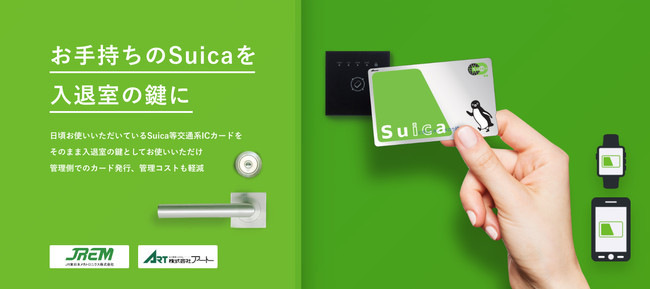
Image from PR Times.
Suica is offered by JR East and is mainly used in the Greater Tokyo, Sendai, and Niigata areas. In May 2023, its services were expanded to the Aomori, Akita and Morioka areas. Suica is an acronym for “Super Urban Intelligent CArd”. Its mascot is a loveable round-headed penguin. Suica is the first IC card company in Japan to launch a mobile IC card service - Mobile Suica.
Welcome Suica, a special version of Suica with a unique design, is available for short-term visitors, namely foreign tourists. It is valid for 28 days from purchase and does not require a deposit. It is non-refundable so make sure to use up the balance within its validity period.
2. PASMO
【お知らせ】本日より、記名の「PASMO」「Suica」カードの発売を一時中止しております。お手持ちの「PASMO」カードは通常通りご利用いただけます。便利な「モバイルのPASMO」もぜひご利用ください。#PASMO #パスモ pic.twitter.com/pJ23hJQ1Pt
— PASMO 【公式】 (@pasmonorobot) August 2, 2023
PASMO is offered by Tokyo Metro especially for non-JR public transportation services in the Tokyo area. Its mascot is a pink robot that can transform itself into a bus or train to get around, and can also change colours! Mobile PASMO service with Android and ApplePay compatibility is available.
PASMO Passport is PASMO’s version of Welcome Suica. It has a unique design, and is available for overseas visitors only. Similarly, it has 28 days validity from purchase, does not require a deposit, and is non-refundable.
3. ICOCA
大阪駅 サウスゲートビルディング16階にある「イチロクグルメ」は知ってる?
— ICOCA電子マネー (@ICOCA_shopping) October 18, 2023
美味グルメを気軽&オシャレに楽しめます♪もちろんお支払いはICOCAで! #ICOCA #大阪駅 #レストラン https://t.co/CprMcdKDJO pic.twitter.com/stNUoREOHT
ICOCA is offered by JR West and is primarily used in the Kansai (Osaka, Kyoto, Kobe) and San'yō regions. The name ICOCA is a pun on 行こうか (Ikouka?) meaning “Shall we go?” Its mascot is a blue platypus that goes by the name Ico-chan. In 2023, Mobile ICOCA for Android and ApplePay become available.
Kansai One Pass is ICOCA’s special foreign visitor’s only IC card. It has no validity period and can be used again anytime you visit the Kansai region. Additionally, you can receive discounts by presenting the card at participating shops and facilities.
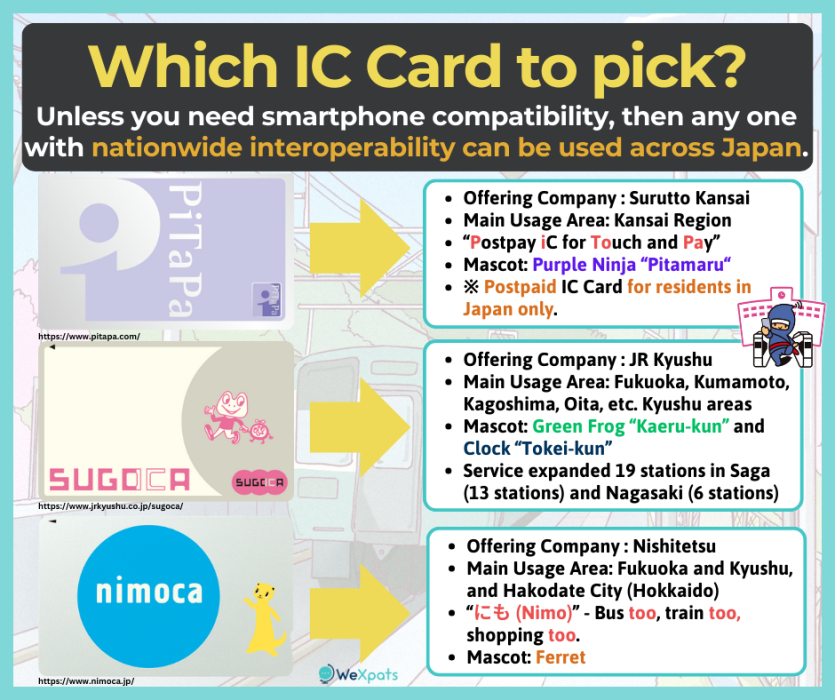
4. PiTaPa
PiTaPa is offered by Surutto Kansai with services mainly for the Kansai region. Unlike the other IC cards we introduced here which are prepaid, PiTaPa is a postpaid card. It is not available to foreign visitors as a Japanese bank account, address, and contact number is required to sign-up. PiTaPa stands for “Postpay iC for Touch and Pay”. Its mascot is a purple dressed ninja named “Pitamaru” that holds a PiTaPa card or shuriken in hand, and signals emitting from the tip of its ninja hood.
5. Kitaca
Kitaca is offered by JR Hokkaido primarily for JR services in the Hokkaido area. Its name is derived from the fact that Hokkaido is the northernmost region in Japan, with Kita (北) meaning north in Japanese. Its mascot is an Ezo Momonga, a species of flying squirrel native to Hokkaido, with the words “Kitaca” on its belly.
6. SUGOCA
JR九州「SUGOCA」2024年度から新たに19駅で使用可能に!詳細こちら→ https://t.co/vrFrmzHeBu pic.twitter.com/N8mhk3rMff
— 福岡のニュース (@TwitFukuoka) August 24, 2022
SUGOCA is offered by JR Kyushu for JR services in the Kyushu area, primarily Fukuoka, but also Kumamoto, Kagoshima, Oita, and etc. The name SUGOCA is an acronym for “Smart Urban GOing CArd”. The official mascot for SUGOCA is a green frog “Kaeru-kun” and a clock “Tokei-kun”; Kaeru-kun even has his whole family, some friends, and a girlfriend illustrated.
On August 22, 2022, JR Kyushu announced that SUGOCA’s usage area will be expanded to include 19 additional stations in Saga (13 stations) and Nagasaki (6 stations) prefectures sometime in 2024. The Nagasaki Huis Ten Bosch station, where Dutch theme park Huis Ten Bosch is located, is one of the stations that will be covered.
※ JR Kyushu, “西九州エリアにICカード乗車券 SUGOCA を導入します!” [PDF] [2022.08.22] ※ Fukuoka NOW, “SUGOCA Expanded to Additional 19 Stations in Kyushu”
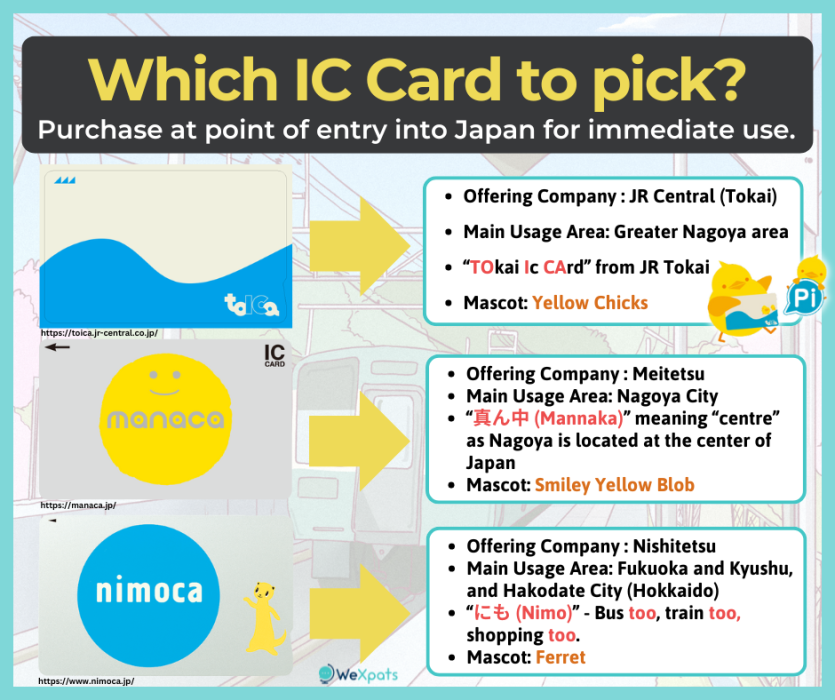
7. TOICA
TOICA is JR Central’s IC card for the Greater Nagoya area. The name TOICA is an abbreviation of “TOkai Ic CArd”; Tokai is JR Central’s Japanese name - JR Tokai (JR 東海). The mascot for TOICA are yellow chicks.
8. manaca
manaca is offered by Meitetsu primarily for public transportation services in Nagoya City and surrounding areas in Aichi prefecture. The name manaca is derived from 真ん中 (Mannaka) meaning “centre”, a reference to Nagoya’s location right at the centre of Japan. manaca’s official mascot is a smiley round yellow blob who has no name.
9. nimoca
【天神】お魚 pic.twitter.com/QnbmkOmRea
— nimoca (@_nimoca) March 20, 2017
nimoca is offered by Nishitetsu. Its primary area of usage is in Fukuoka prefecture and the Kyushu area, and also in Hokkaido, especially Hakodate City, where it is known as “ICAS nimoca”. nimoca’s name is derived from the particle にも (Nimo) meaning “too” or “also”, as in “Bus too, train too, shopping too”, it represents nimoca’s versatileness. The official mascot for nimoca is a ferret designed by Nakano Shirou who we have to thank for other beloved mascots - Hiyoko-chan (Nissin Chicken Ramen) and Ponta (Ponta Point Card).
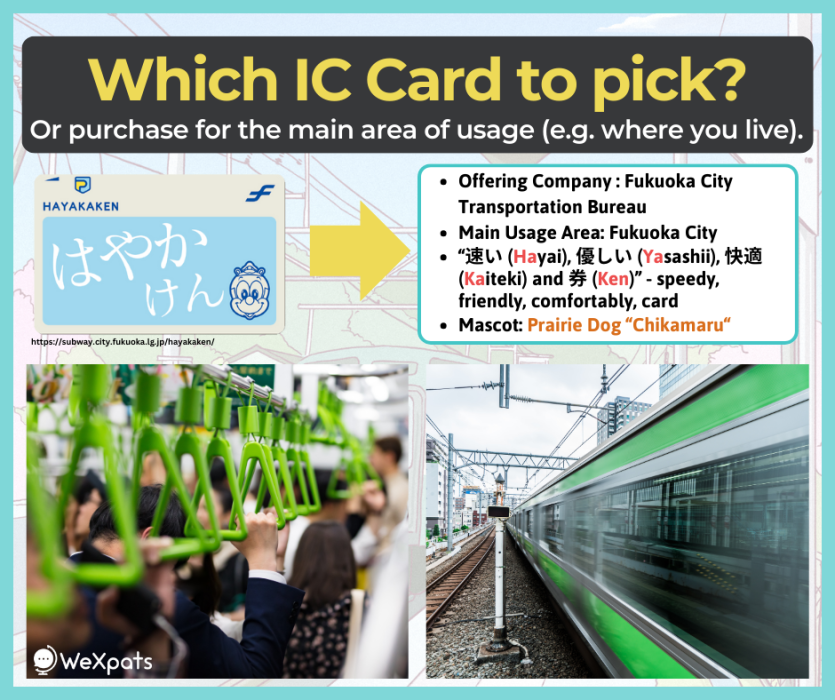
10. Hayakaken
Hayakaken, typically written in Hiragana はやかけん, is offered by the Fukuoka City Transportation Bureau and is primarily used for public transportation in Fukuoka City. Its name is an acronym for 速い (Hayai), 優しい (Yasashii), 快適 (Kaiteki) and 券 (Ken), aka speedy, friendly, comfortably, card. Hayakaken’s mascot is a prairie dog named “Chikamaru”
To Close
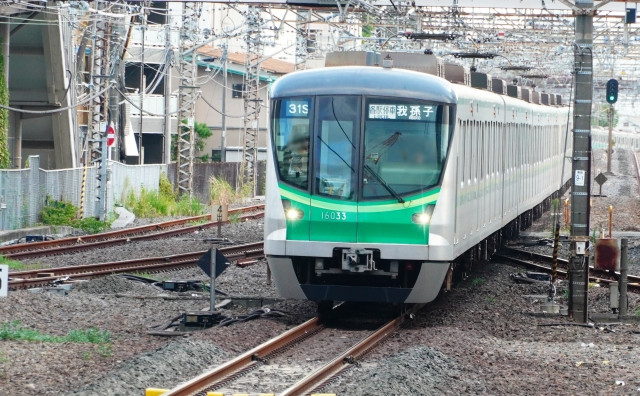
Japan IC Cards are convenient and necessary tools for commuters and travellers alike. Among the many IC cards there are, we recommend choosing one of the major 10 IC cards that have nationwide interoperability. Select one for the area you are living in to maximise their benefits.
Keep in mind that Japan IC cards do not cover travel by Shinkansen, highway buses, and other trains that require a supplement fee like limited express trains. Inquire with the station attendants or do some research online if in doubt.








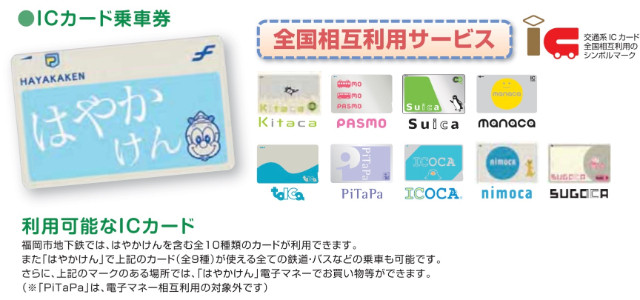 Image from
Image from 
.jpg)

























